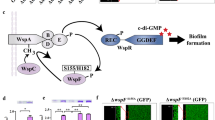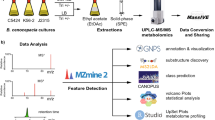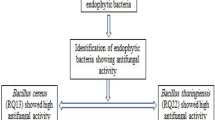Abstract
In addition to producing lethal antibiotics, microorganisms may also use a new form of antagonistic mechanism in which signal molecules are exported to influence the gene expression and hence the ecological competence of their competitors. We report here the isolation and characterization of a novel signaling molecule, cis-2-dodecenoic acid (BDSF), from Burkholderia cenocepacia. BDSF is structurally similar to the diffusible signal factor (DSF) that is produced by the RpfF enzyme of Xanthomonas campestris. Deletion analysis demonstrated that Bcam0581, which encodes an RpfF homologue, was essential for BDSF production. The gene is highly conserved and widespread in the Burkholderia cepacia complex. Exogenous addition of BDSF restored the biofilm and extracellular polysaccharide production phenotypes of Xanthomonas campestris pv. campestris DSF-deficient mutants, highlighting its potential role in inter-species signaling. Further analyses showed that Candida albicans germ tube formation was strongly inhibited by either coculture with B. cenocepacia or by exogenous addition of physiological relevant levels of BDSF, whereas deletion of Bcam0581 abrogated the inhibitory ability of the bacterial pathogen. As B. cenocepacia and C. albicans are frequently encountered human pathogens, identification of the BDSF signal and its activity thus provides a new insight into the molecular grounds of their antagonistic interactions whose importance to microbial ecology and pathogenesis is now becoming evident.
Similar content being viewed by others
Log in or create a free account to read this content
Gain free access to this article, as well as selected content from this journal and more on nature.com
or
References
Altschul SF, Gish W, Miller W, Myers EW, Lipman DJ . (1990). Basic local alignment search tool. J Mol Biol 215: 403–410.
Barber CE, Tang JL, Feng JX, Pan MQ, Wilson TJ, Slater H et al. (1997). A novel regulatory system required for pathogenicity of Xanthomonas campestris is mediated by a small diffusible signal molecule. Mol Microbiol 24: 555–566.
Bassler BL, Losick R . (2006). Bacterially speaking. Cell 125: 237–246.
Braun BR, Head WS, Wang MX, Johnson AD . (2000). Identification and characterization of TUP1-regulated genes in Candida albicans. Genetics 156: 31–44.
Coenye T, Vandamme P, Govan JR, LiPuma JJ . (2001). Taxonomy and identification of the Burkholderia cepacia complex. J Clin Microbiol 39: 3427–3436.
Dong YH, Zhang XF, Xu JL, Zhang LH . (2004). Insecticidal Bacillus thuringiensis silences Erwinia carotovora virulence by a new form of microbial antagonism—signal interference. Appl Environ Microbiol 70: 954–960.
Figurski DH, Helinski DR . (1979). Replication of an origin-containing derivative of plasmid RK2 dependent on a plasmid function provided in trans. Proc Natl Acad Sci USA 76: 1648–1652.
Finn RD, Mistry J, Schuster-Bockler B, Griffiths-Jones S, Hollich V, Lassmann T et al. (2006). Pfam: clans, web tools and services. Nucleic Acids Res 34: 247–251.
Fuqua C, Greenberg EP . (2002). Listening in on bacteria: acyl-homoserine lactone signalling. Nat Rev Mol Cell Biol 3: 685–695.
Goldmann DA, Klinger JD . (1986). Pseudomonas cepacia: biology, mechanisms of virulence, epidemiology. J Pediatr 108: 806–812.
Govan JR, Brown PH, Maddison J, Doherty CJ, Nelson JW, Dodd M et al. (1993). Evidence for transmission of Pseudomonas cepacia by social contact in cystic fibrosis. Lancet 342: 15–19.
He YW, Ng AY, Xu M, Lin K, Wang LH, Dong YH et al. (2007). Xanthomonas campestris cell–cell communication involves a putative nucleotide receptor protein Clp and a hierarchical signalling network. Mol Microbiol 64: 281–292.
He YW, Wang C, Zhou L, Song H, Dow JM, Zhang LH . (2006a). Dual signaling functions of the hybrid sensor kinase RpfC of Xanthomonas campestris involve either phosphorelay or receiver domain–protein interaction. J Biol Chem 281: 33414–33421.
He YW, Xu M, Lin K, Ng YJ, Wen CM, Wang LH et al. (2006b). Genome scale analysis of diffusible signal factor regulon in Xanthomonas campestris pv. campestris: identification of novel cell–cell communication-dependent genes and functions. Mol Microbiol 59: 610–622.
Hermann C, Hermann J, Munzelb U, Ruchel R . (1999). Bacterial flora accompanying Candida yeasts in clinical specimens. Mycoses 42: 619–627.
Hoang TT, Karkhoff-Schweizer RR, Kutchma AJ, Schweizer HP . (1998). A broad-host-range Flp-FRT recombination system for site-specific excision of chromosomally-located DNA sequences: application for isolation of unmarked Pseudomonas aeruginosa mutants. Gene 212: 77–86.
Hogan DA, Vik A, Kolter R . (2004). A Pseudomonas aeruginosa quorum-sensing molecule influences Candida albicans morphology. Mol Microbiol 54: 1212–1223.
Isles A, Maclusky I, Corey M, Gold R, Prober C, Fleming P et al. (1984). Pseudomonas cepacia infection in cystic fibrosis: an emerging problem. J Pediatr 104: 206–210.
Kerr J . (1994). Inhibition of fungal growth by Pseudomonas aeruginosa and Pseudomonas cepacia isolated from patients with cystic fibrosis. J Infect 28: 305–310.
Lefebre MD, Valvano MA . (2002). Construction and evaluation of plasmid vectors optimized for constitutive and regulated gene expression in Burkholderia cepacia complex isolates. Appl Environ Microbiol 68: 5956–5964.
Lewenza S, Conway B, Greenberg EP, Sokol PA . (1999). Quorum sensing in Burkholderia cepacia: identification of the LuxRI homologs CepRI. J Bacteriol 181: 748–756.
Lo HJ, Kohler JR, DiDomenico B, Loebenberg D, Cacciapuoti A, Fink GR . (1997). Nonfilamentous C. albicans mutants are avirulent. Cell 90: 939–949.
Lutter E, Lewenza S, Dennis JJ, Visser MB, Sokol PA . (2001). Distribution of quorum-sensing genes in the Burkholderia cepacia complex. Infect Immun 69: 4661–4666.
Mahenthiralingam E, Baldwin A, Vandamme P . (2002). Burkholderia cepacia complex infection in patients with cystic fibrosis. J Med Microbiol 51: 533–538.
Mahenthiralingam E, Urban TA, Goldberg JB . (2005). The multifarious, multireplicon Burkholderia cepacia complex. Nat Rev Microbiol 3: 144–156.
Mahenthiralingam E, Vandamme P, Campbell ME, Henry DA, Gravelle AM, Wong LT et al. (2001). Infection with Burkholderia cepacia complex genomovars in patients with cystic fibrosis: virulent transmissible strains of genomovar III can replace Burkholderia multivorans. Clin Infect Dis 33: 1469–1475.
Riedel K, Hentzer M, Geisenberger O, Huber B, Steidle A, Wu H et al. (2001). N-acylhomoserine-lactone-mediated communication between Pseudomonas aeruginosa and Burkholderia cepacia in mixed biofilms. Microbiology 147: 3249–3262.
Ryan RP, Fouhy Y, Lucey JF, Crossman LC, Spiro S, He YW et al. (2006). Cell–cell signaling in Xanthomonas campestris involves an HD-GYP domain protein that functions in cyclic di-GMP turnover. Proc Natl Acad Sci USA 103: 6712–6717.
Ryan RP, Fouhy Y, Lucey JF, Jiang BL, He YQ, Feng JX et al. (2007). Cyclic di-GMP signalling in the virulence and environmental adaptation of Xanthomonas campestris. Mol Microbiol 63: 429–442.
Saville SP, Lazzell AL, Monteagudo C, Lopez-Ribot JL . (2003). Engineered control of cell morphology in vivo reveals distinct roles for yeast and filamentous forms of Candida albicans during infection. Eukaryot Cell 2: 1053–1060.
Wang LH, He Y, Gao Y, Wu JE, Dong YH, He C et al. (2004). A bacterial cell–cell communication signal with cross-kingdom structural analogues. Mol Microbiol 51: 903–912.
Whitehead NA, Barnard AM, Slater H, Simpson NJ, Salmond GP . (2001). Quorum-sensing in Gram-negative bacteria. FEMS Microbiol Rev 25: 365–404.
Zhang HB, Wang LH, Zhang LH . (2002). Genetic control of quorum-sensing signal turnover in Agrobacterium tumefaciens. Proc Natl Acad Sci USA 99: 4638–4643.
Zhang LH, Dong YH . (2004). Quorum sensing and signal interference: diverse implications. Mol Microbiol 53: 1563–1571.
Zheng XD, Wang YM, Wang Y . (2003). CaSPA2 is important for polarity establishment and maintenance in Candida albicans. Mol Microbiol 49: 1391–1405.
Acknowledgements
We are grateful to M Valvano for his generous gift of the plasmid pMLS7 and to Sanger Institute for providing us access to recent annotation of B. cenocepacia J2315 genome. We appreciate the advice provided by M Holden and E Mahenthiralingam on the ARTEMIS software and Bcc strains, respectively. We thank the laboratory of Wang Yue for providing the SC5314 strain and technical advice in microscopy. This work was financially supported by the Agency of Science, Technology and Research (A*Star), Singapore.
Author information
Authors and Affiliations
Corresponding author
Rights and permissions
About this article
Cite this article
Boon, C., Deng, Y., Wang, LH. et al. A novel DSF-like signal from Burkholderia cenocepacia interferes with Candida albicans morphological transition. ISME J 2, 27–36 (2008). https://doi.org/10.1038/ismej.2007.76
Received:
Revised:
Accepted:
Published:
Issue date:
DOI: https://doi.org/10.1038/ismej.2007.76
Keywords
This article is cited by
-
Gram-negative bacteria resist antimicrobial agents by a DzrR-mediated envelope stress response
BMC Biology (2023)
-
Insight into the Physiological and Molecular Crosstalk During Bacterial-Fungal Interactions
Current Clinical Microbiology Reports (2023)
-
The role of bacterial signaling networks in antibiotics response and resistance regulation
Marine Life Science & Technology (2022)
-
Biofilm formation and inhibition mediated by bacterial quorum sensing
Applied Microbiology and Biotechnology (2022)
-
The predatory soil bacterium Lysobacter reprograms quorum sensing system to regulate antifungal antibiotic production in a cyclic-di-GMP-independent manner
Communications Biology (2021)



